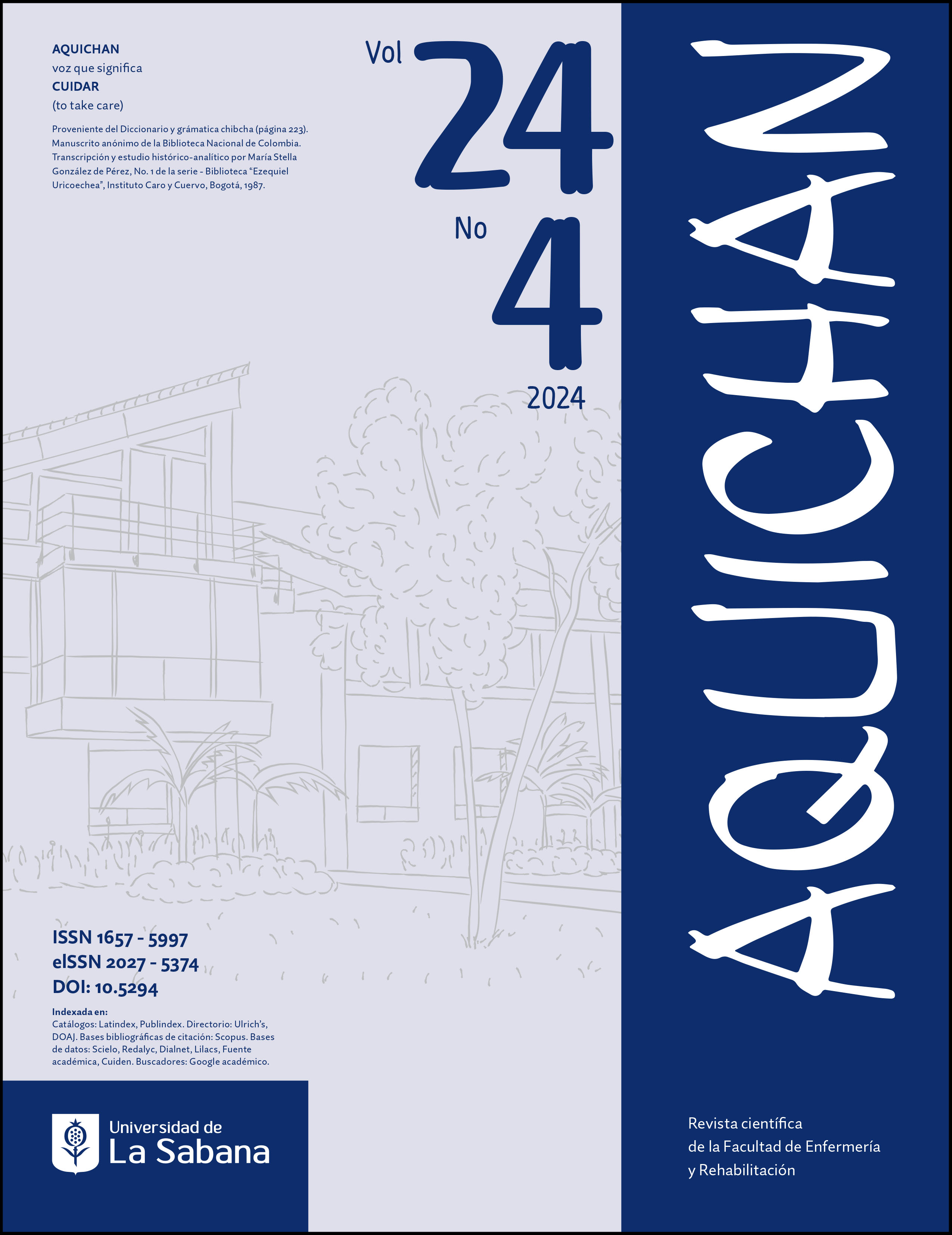Identification of Professional Nursing Care Needs: Experiences of Hospitalized High-Risk Pregnant Women
DOI:
https://doi.org/10.5294/aqui.2024.24.4.5Keywords:
Nursing care, high-risk pregnancy, maternal and child health, pregnant women, qualitative research, nurse-patient relationshipsAbstract
Introduction: Understanding the world of pregnant women with high obstetric risk (HOBR), contemplating the reality they live in, allows for a profound understanding of the meanings they assign to their care. This contributes to establishing person-centered care. Objective: To understand the experiences of hospitalized HOBR pregnant women in a highly complex health institution regarding the care provided by nursing professionals in identifying their needs. Materials and Methods: A qualitative interpretative study was conducted from 2017 to 2019 in the HOBR unit of the Hospital Universitario del Valle, Colombia. On average, two in-depth interviews were conducted with each of the ten women in the sample of the ten pregnant women of sample, until the criterion of saturation of meanings was reached. The analysis and interpretation conceptualized the participants’ reality based on emergent topics from the narrated facts, identifying similarities and differences, which allowed the determination of categories under Benner’s philosophical concepts. Results: the research explained how care is delivered, based on Swanson’s theoretical framework. Four categories were identified: 1) The pregnant woman-nurse relationship: Care involved; 2) The meanings of their lived experiences; 3) Hospitalization as a circumstance that disrupts the pregnant woman’s connection with her loved ones, and 4) The experiences of pregnant women as a source of meaning to understand the institutional context. Conclusions: Addressing the expressed needs of pregnant women enables nursing professionals to advance in care practices informed by Swanson’s theory.
Downloads
References
World Health Organization. Centro de prensa, nota descriptiva de mortalidad materna; 2023. http://www.who.int/mediacentre/factsheets/fs348/es/
Pinilla Saraza ME. Mortalidad materna en Colombia, 2019. REN [Internet]. 2021;2(3):27-42. https://doi.org/10.33610/01229907.2020v2n3a3
Holness N. High-risk pregnancy. Nurs Clin North Am. 2018;53(2):241-251. https://doi.org/10.1016/j.cnur.2018.01.010
Rodrigues DB, Backes MTS, Delziovo CR, Santos EKA, Damiani PR, Vieira VM. Complejidad de la atención al embarazo de alto riesgo en la red de atención de salud. Rev Gaúcha Enferm. 2022;43:e20210155. https://doi.org/10.1590/1983-1447.2022.20210155.en
Mirzakhani K, Ebadi A, Faridhosseini F, Khadivzadeh T. Well-being in high-risk pregnancy: an integrative review. BMC Pregnancy Childbirth. 2020;20(1):526. https://doi.org/10.1186/s12884-020-03190-6
Isaacs NZ, Andipatin MG. A systematic review regarding women’s emotional and psychological experiences of high-risk pregnancies. BMC Psychol. 2020;8(1):45. https://doi.org/10.1186/s40359-020-00410-8
Kazi AK, Rowther AA, Atif N, Nazir H, Atiq M, Zulfiqar S, et al. Intersections between patient-provider communication and antenatal anxiety in a public healthcare setting in Pakistan. PLoS ONE. 2021;16(2):e0244671. https://doi.org/10.1371/journal.pone.0244671
Beristain-García I, Álvarez-Aguirre A, Huerta-Baltazar MI, Casique-Casique L. Teoría de los cuidados de Kristen Swanson: revisión de literatura. Sanus. 2022;7:e212. https://doi.org/10.36789/revsanus.vi1.212
Opara UC, Petrucka P. A Critical comparison of focused ethnography and interpretive phenomenology in Nursing research. Glob Qual Nurs Res. 2024;11:23333936241238097. https://doi.org/10.1177/23333936241238097
Sanguino NC. Fenomenología como método de investigación cualitativa: preguntas desde la práctica investigativa. Revista latinoamericana de metodología de la investigación, social. 2020;(20):7-18. http://relmis.com.ar/ojs/index.php/relmis/article/view/fenomenologia_como_metodo
Duque H, Aristizábal Díaz-Granados E. Análisis fenomenológico interpretativo. Una guía metodológica para su uso en la investigación cualitativa en psicología. Pensando Psicología. 2019;15(25):1-24. https://doi.org/10.16925/2382-3984.2019.01.03
Santos RP, Neves ET, Carnevale F. Qualitative methodologies in health research: interpretive referential of Patricia Benner. Rev Bras Enferm [Internet]. 2016;69(1):178-82. https://doi.org/10.1590/0034-7167.2016690125i
Burns M, Peacock S. Interpretive phenomenological methodologists in nursing: A critical analysis and comparison. Nurs Inq. 2019;26(2):e12280. https://doi.org/10.1111/nin.12280
Silva Cancio VI, Soares Tizzoni J. Critérios e estratégias de qualidade e rigor na pesquisa qualitativa. Cienc. enferm. 2020;26:28. https://doi.org/10.29393/CE26-22CEIS20022
Henao-Castaño AM, Vergara-Escobar OJ, Gómez-Ramírez OJ. Humanización de la atención en salud: análisis del concepto. Rev. cienc. cuidad. 2021;18(3):84-95. https://doi.org/10.22463/17949831.2791
Yáñez FK, Rivas RE, Campillay CM. Ética del cuidado y cuidado de enfermería. Enfermería (Montevideo) [Internet]. 2021;10(1):3-17. https://doi.org/10.22235/ech.v10i1.2124
Nagraj S, Hinton L, Praveen D, Kennedy S, Norton R, Hirst J. Women’s and healthcare providers’ perceptions of long-term complications associated with hypertension and diabetes in pregnancy: A qualitative study. BJOG. 2019;126(Suppl 4):34-42. https://doi.org/10.1111/1471-0528.15847
Souza BF, Bussadori JCC, Ayres JRCM, Fabbro MRC, Wernet M. Nursing and hospitalized high-risk pregnant women: Challenges for comprehensive care. Rev esc enferm USP. 2020;54:e03557. https://doi.org/10.1590/s1980-220x2018036903557
Müggenburg C, Riveros-Rosas A, Juárez-García F. Training in communication skills for nurses, and the perception of the patients who receive their care. Enfermería Universitaria. 2016;13(4):201-207. https://doi.org/10.1016/j.reu.2016.08.001
Noguera Ortiz N, Muñoz de Rodríguez L. Significados que las gestantes hospitalizadas le atribuyen a la experiencia de tener preeclampsia. Investig. Enferm. Imagen Desarro. 2014;16(1):27-48. https://doi.org/10.11144/Javeriana.IE16-1.sgha
Souza BF, Bussadori JCC, Ayres JRCM, Fabbro MRC, Wernet M. Nursing and hospitalized high-risk pregnant women: Challenges for comprehensive care. Rev Esc Enferm USP. 2020;54:e03557. https://doi.org/10.1590/s1980-220x2018036903557
Mirzakhani K, Ebadi A, Faridhosseini F, Khadivzadeh T. Pregnant women’s experiences of well-being in high-risk pregnancy: A qualitative study. J Educ Health Promot. 2023;12(1):6. https://doi.org/10.4103/jehp.jehp_1542_21
Diego-Cordero R, Suárez-Reina P, Badanta B, Lucchetti G, Vega-Escaño J. The efficacy of religious and spiritual interventions in nursing care to promote mental, physical and spiritual health: A systematic review and meta-analysis. Appl Nurs Res. 2022; 67:151618. https://doi.org/10.1016/j.apnr.2022.151618
Benner P, Wrubel J. The primacy of caring: stress and coping in health and illness. Menlo Park (CA/USA): Addison Wesley; 1989.
Amorim TV, Souza Ívis EO, Moura MAV, Queiroz ABA, Salimena AMO. Perspectivas de los cuidados de enfermería en el embarazo de alto riesgo: revisión integradora. Enf Global. 2017;16(2):500-43. https://doi.org/10.6018/eglobal.16.2.238861
Downloads
Published
How to Cite
Issue
Section
License
Copyright (c) 2025 María Eugenia Acevedo Cano, Martha Lucía Vásquez Truisi

This work is licensed under a Creative Commons Attribution 4.0 International License.
1. Proposed Policy for Journals That Offer Open Access
Authors who publish with this journal agree to the following terms:
- The journal and its papers are published with the Creative Commons License Attribution-NonCommercial-NoDerivatives 4.0 International (CC BY-NC-ND 4.0). You are free to share copy and redistribute the material in any medium or format if you: give appropriate credit, provide a link to the license, and indicate if changes were made; don’t use our material for commercial purposes; don’t remix, transform, or build upon the material.









